I am learning Sequential Consistency in Distributed Systems but just could not understand the terms explained. I would appreciate if someone can shed some light in layman's term on why (a) and (c) below are sequentially consistent and (b) is not.
Thanks.
- 415
- 1
- 8
- 22
1 Answers
An execution e of operations is sequentially consistent if and only if it can be permutated into a sequence s of these operations such that:
the sequence
srespects the program order of each process. That is, for any two operationso1ando2which are of the same process and ifo1precedeso2ine, theno1should be placed beforeo2ins;in the sequence
s, each read operation returns the value of the last preceding write operation over the same variable.
For (a), s can be:
W(x)b [P2], R(x)b [P3], R(x)b [P4], W(x)a [P1], R(x)a [P3], R(x)a [P4]
For (c), s can be:
W(x)a [P1], R(x)a [P2], R(x)a [P3], R(x)a [P4], W(x)b [P3], R(x)b [P1], R(x)b [P2], R(x)b [P4]
However, for (b):
the operations
R(x)b, R(x)afromP3require thatW(x)bcome beforeW(x)athe operations
R(x)a, R(x)bfromP4require thatW(x)acome beforeW(x)b
It is impossible to construct such a sequence s.
- 464
- 1
- 6
- 20
- 1,867
- 2
- 21
- 42
-
1Second point is a bit misleading. A read operation on the process that wrote the value should return it's written value or anything newer (as soon as it returns newer value, it can't return older values anymore). On any other processes, reads can return older values, as long as it complies with write order (it doesn't traverse time backward). So for example, in case (C), R(x) on P1 can return "a", but if it returns "b", then from that point onward, it can't return "a" anymore. – Majid Azimi Jun 12 '18 at 13:10
-
As more info, please take a look at [here](https://cs.gmu.edu/~setia/cs707/slides/consistency.pdf). Slide number 8 says: "Definition of sequential consistency says nothing about time -- **there is no reference to the most recent write operation**" – Majid Azimi Jun 12 '18 at 13:23
-
This [link](https://www.e-reading.club/chapter.php/143358/218/Tanenbaum_-_Distributed_operating_systems.html), also corroborates my comment. Specially the first figure. – Majid Azimi Jun 12 '18 at 13:31
-
@MajidAzimi Yes, it does not refer to time. However, it does refer to a total order/permutation/sequence of operations based on which the notion of "the most recent" is well-defined. – hengxin Jun 12 '18 at 14:01
-
Why the operations R(x)b, R(x)a from P3 require that W(x)b come before W(x)a? – noobcoder Dec 09 '19 at 01:25